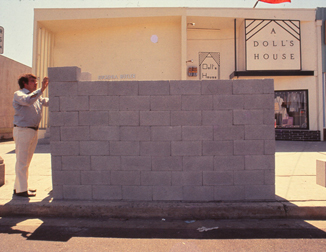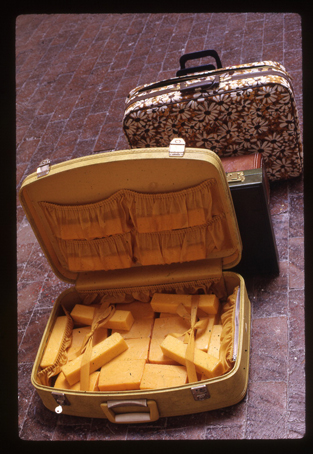
Staple Cheese: A Race (1960)
Dieter Roth
In 1970, after having seen Dieter Roth's work in Dusseldorf, Eugenia Butler, Sr., offered Roth his first exhibition in the United States. Roth began to conceptualize his exhibition for the space: a time-based work that included the installation of thirty-seven suitcases filled with unwrapped cheddar, Limburger, Camembert, Brie, and various other cheeses. Titled Staple Cheese: A Race, the cases were to be opened, one a day until the end of the exhibition. Additionally, pieces of cheese were pressed against plastic panels mounted to the wall, a horizontal "finish line" below that tracked the "race's" winner. After only a few days, the smell from the exhibition made it almost impossible to enter the room. "There they were like assorted luggage of some famous actress at a railroad station. They stood there shiny and beautiful—only gradually becoming disgusting. First juice started oozing out, then the maggots came, and then, of course, flies started laying their eggs," Roth said of the exhibition. This caught the eye of local health authorities, and, after less than three weeks, two inspectors arrived at the gallery to serve Butler a summons that stated the space was being operated or maintained in "A manner as to permit the breeding or harboring of flies."
Variety of cheese stuffed into thirty-seven suitcases
Image courtesy of Eugenia P. Butler Estate © Eugenia P. Butler Estate
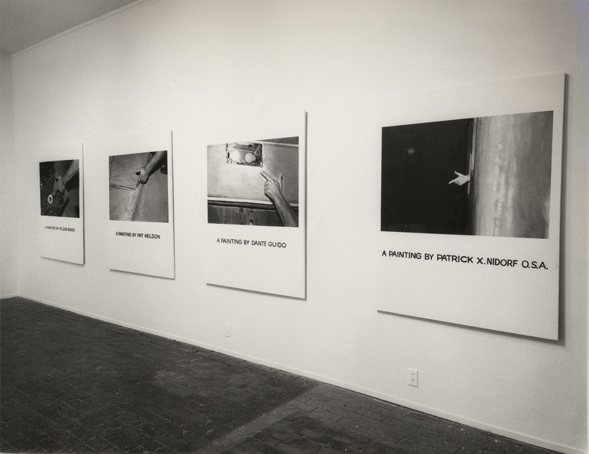
Installation Image of John Baldessari Exhibition at the Eugenia Butler Gallery, Featuring Works from the Commissioned Painting Series (1970)
John Baldessari
Image courtesy of the artist

Untitled, Postcard to Eugenia Butler (1969)
Dieter Roth
Acrylic paint on postcard 2 1/3 x 1 2/3 in
Image courtesy of Eugenia P. Butler Estate © Eugenia P. Butler Estate
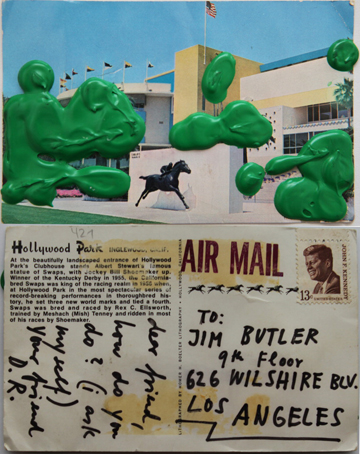
Untitled, Postcard to Jim Butler (1969)
Dieter Roth
Acrylic paint on postcard 1 3/8 x 2 1/6 in
Image courtesy of Eugenia P. Butler Estate © Eugenia P. Butler Estate

25 Complimentary Cards, 25 Uncomplimentary Cards (1971)
Dorothy Iannone
Ink on paper 4 3/4 x 1 1/4 x 3 3/8 in. each
Image courtesy of Eugenia P. Butler Estate © Eugenia P. Butler Estate
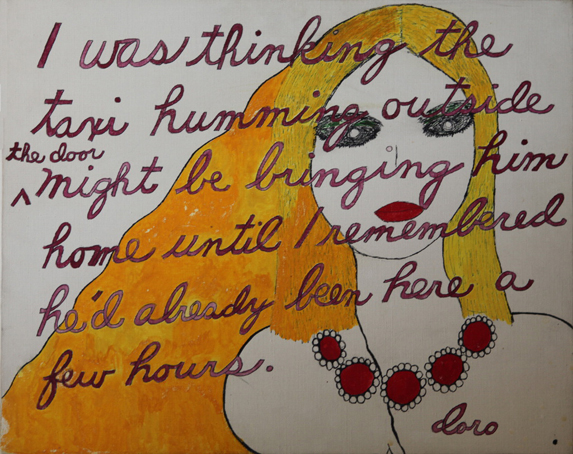
I Was Thinking... (1976)
Dorothy Iannone
Although Dorothy Iannone never exhibited at the Eugenia Butler Gallery, her work was actively collected by the gallerist. This particular piece, somewhat demure compared to her other works that actively deal with sexuality, refers to her longtime partner and muse, Dieter Roth, who had his first U.S. exhibit at the Eugenia Butler Gallery. Due to the explicit content of her work, Ianonne's art was often subject to censorship. Archives from the Gallery reveal a letter between Butler's husband, who was a lawyer, giving advice to Berlin-based Iannone on how to avoid having her work confiscated at U.S. Customs. He explained that if her work was confiscated due to pornographic content, it would likely be destroyed or sent for research purposes to the Kinsey Institute.
Goauache and ink on canvas 13 x 16 in
Image courtesy of Eugenia P. Butler Estate © Eugenia P. Butler Estate
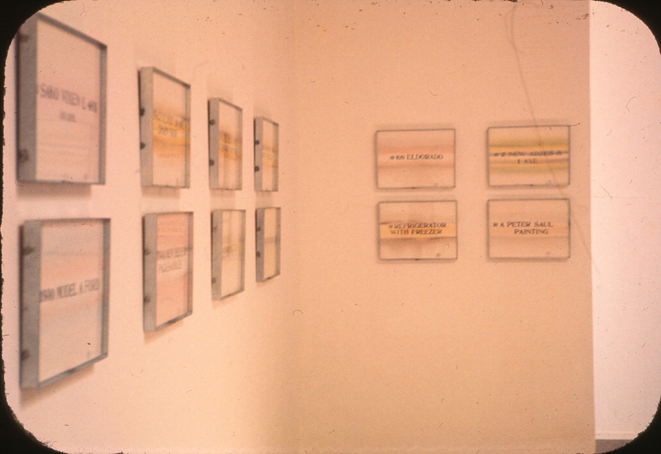
Installation Shot of Watercolor Show at the Eugenia Butler Gallery (1969)
Edward Kienholz
Ed Kienholz’s Watercolors exhibit, sometimes referred to as The Barter Show, was said to have caused a buying frenzy on opening night. Each hand-printed piece stated what the artist wanted in exchange for his work, and each was decorated with a swash of watercolor and signed in pencil next to his thumbprint—an early acknowledgement of the cult of celebrity and the commodification of art.
Image courtesy of Eugenia P. Butler Estate © Eugenia P. Butler Estate

Trade Watercolor (for Timex Electric Watch), Signed and Dated in Pencil with Thumbprint (1969)
Edward Kienholz
Ed Kienholz's Watercolors exhibit, sometimes referred to as The Barter Show, was said to have caused a buying frenzy on opening night. Each hand-printed piece stated what the artist wanted in exchange for his work, and each was decorated with a swash of watercolor and signed in pencil next to his thumbprint—an early acknowledgement of the cult of celebrity and the commodification of art.
Watercolor in metal frame 12 x 16 in
Image courtesy of Eugenia P. Butler Estate © Eugenia P. Butler Estate
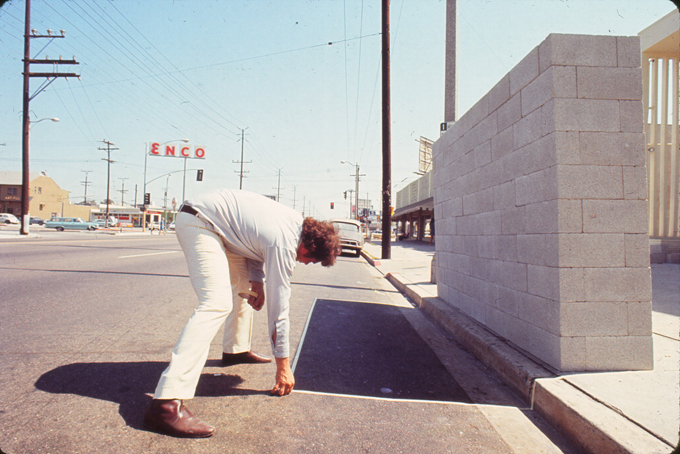
Eric Orr Installing Wall Shadow (1968)
Eric Orr
Brick wall, light, shadow
Image courtesy of Eugenia P. Butler Estate © The Eric Orr Estate

Eric Orr Installing Wall Shadow (1968)
Eric Orr
This image is from Eric Orr’s performance Wall Shadow, which took place in front of the Eugenia Butler Gallery, in which he created a stacked brick wall and drew its shadow. For Pacific Standard Time's Public and Performance Art Festival, LAND will stage a re-creation of Orr's performance.
Brick wall, light, shadow
Image courtesy of Eugenia P. Butler Estate © The Eric Orr Estate

Eric Orr Installing Wall Shadow (1968)
Eric Orr
This image is from Eric Orr’s performance Wall Shadow, which took place in front of the Eugenia Butler Gallery, in which he created a stacked brick wall and drew its shadow. In a recent oral history interview with Richard Jackson, another artist that exhibited at the gallery, Jackson expressed that Butler was a gallerist with exhibitions ahead of their time, which often had little resonance with the general public. He shared an anecdote of a break-in at the gallery where thieves had cut a hole through Butler’s office to get access to the adjacent dress shop seen in this photo to steal clothes, passing up artwork that would have been a much better long-term investment. For Pacific Standard Time's Public and Performance Art Festival, LAND will stage a re-creation of Orr's performance.
Brick wall, light, shadow
Image courtesy of Eugenia P. Butler Estate © The Eric Orr Estate
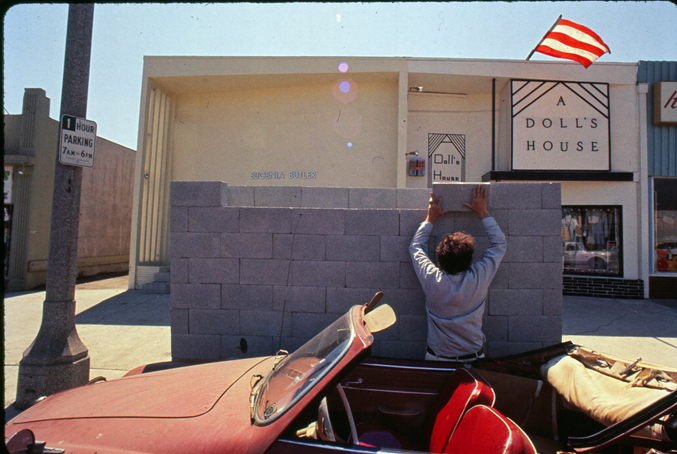
Eric Orr Installing Wall Shadow (1968)
Eric Orr
This image is from Eric Orr's performance Wall Shadow, which took place in front of the Eugenia Butler Gallery, in which he created a stacked brick wall and drew its shadow. In a recent oral history interview with Richard Jackson, another artist that exhibited at the gallery, Jackson expressed that Butler was a gallerist with exhibitions ahead of their time, which often had little resonance with the general public. He shared an anecdote of a break-in at the gallery where thieves had cut a hole through Butler's office to get access to the adjacent dress shop seen in this photo to steal clothes, passing up artwork that would have been a much better long-term investment. For Pacific Standard Time's Public and Performance Art Festival, LAND will stage a re-creation of Orr's performance.
Brick wall, light, shadow
Image courtesy of Eugenia P. Butler Estate © The Eric Orr Estate
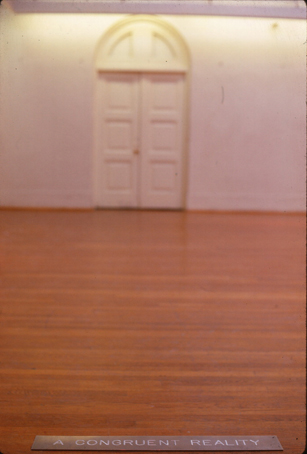
Congruent Reality (1969)
Eugenia P. Butler
Time-based Perceptual/Conceptual Event (Conscious Presence within the Continuum of Time), text on aluminum plate 8 x 64 in
Image courtesy of Eugenia P. Butler Estate © Eugenia P. Butler Estate
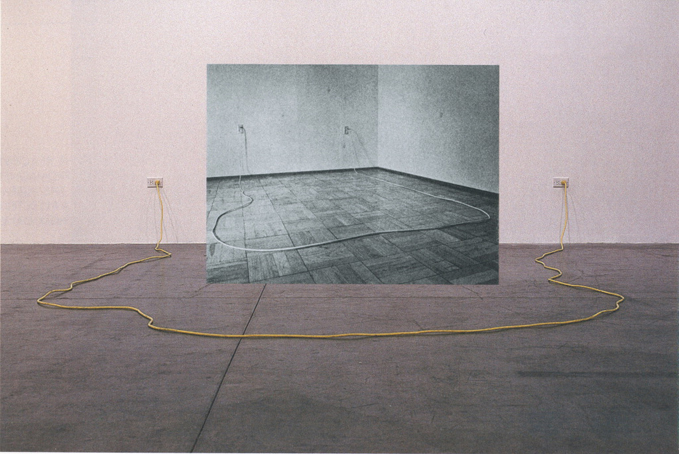
Electric Cord Piece (1967)
Eugenia P. Butler
Eugenia P. Butler, daughter to gallerist Eugenia Butler, Sr., was the only female artist that was exhibited at the gallery. She played a formative but often overlooked role in the Conceptual art movement, with early text-based works, such as Negative Space Hole and A Congruent Reality, which were conceived of as invisible sculptures meant to prompt the activation of the viewer’s imagination to complete the pieces.
Electric cord, two plugs, two sockets
Image courtesy of Eugenia P. Butler Estate © Eugenia P. Butler Estate

Non Tacate I Fili (Do Not Touch the Children) (1964)
Eugenio Carmi
Metal plates on wood 41 1/2 x 29 in
Image courtesy of Eugenia P. Butler Estate © Eugenia P. Butler Estate

Cuero que ata Polledro con Amarillento (1966)
Gustavo Torner
Plexiglass cube 10 1/2 x 15 1/4 in
Image courtesy of Eugenia P. Butler Estate © Eugenia P. Butler Estate
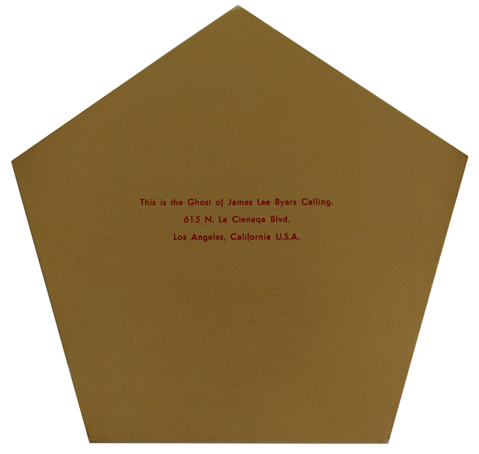
This Is the Ghost of James Lee Byars Calling announcement for performance at the Eugenia Butler Gallery (1969)
James Lee Byars
James Lee Byars had two concurrent exhibits at the Eugenia Butler Gallery in 1970. In Walling Off Jeannie, he had two walls built. The first was just inside the front door of the gallery and obstructed access for visitors. A small hole was cut at the bottom of the wall and visitors had to crawl through that hole to get into the gallery. A second wall was built at Byars’s request to separate Butler’s office from those visiting the gallery—a playful jab at Butler, who was his friend and enjoyed interacting with the public. The back wall of the gallery was painted red for his performance This is the Ghost of James Lee Byars Calling. During the performance, a woman dressed in a red silk suit sat on a stool in the corner of the room with a paper and a red marker, and she wrote answers to questions sent from a simultaneous Byars performance in Antwerp, Belgium, on the day of his thirty-seventh birthday.
Pentagonal piece of white card gilded on one side; on the gilded side, text printed offset in red: "This is the Ghost of Hamess Lee Byars Calling. 615 N. La Cienega Blvd, Los Angeles, California, U.S.A." Text (height): 1/5 in. high Pentagon: 6 1/3 in
Published for the performance at Eugenia Butler Gallery, Los Angeles, 1969 © Eugenia P. Butler Estate
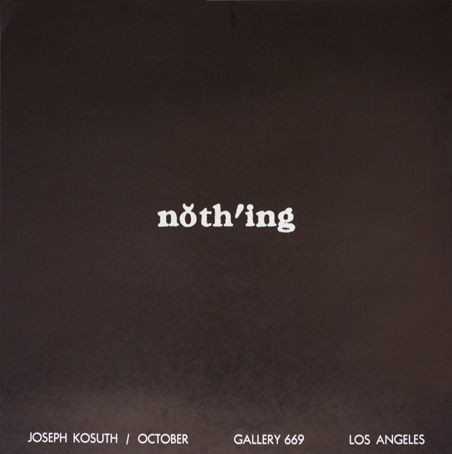
Poster for Nothing Show at Gallery 669 (1968)
Joseph Kosuth
Poster announcement for exhibition 24 x 24 in
Image courtesy of Eugenia P. Butler Estate © Joseph Kosuth
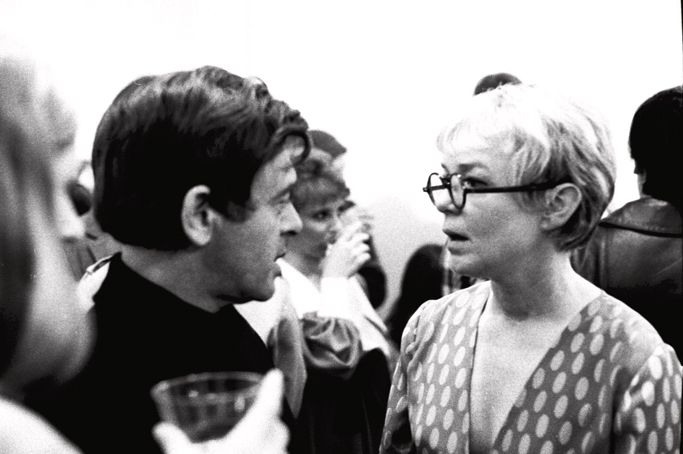
Eugenia Butller, Sr., speaking with Rudi Gernreich, at the Edward Kienholz Barter Exhibition (1969)
Malcolm Lubliner
Photograph by Malcolm Lubliner All rights reserved © Malcolm Lubliner
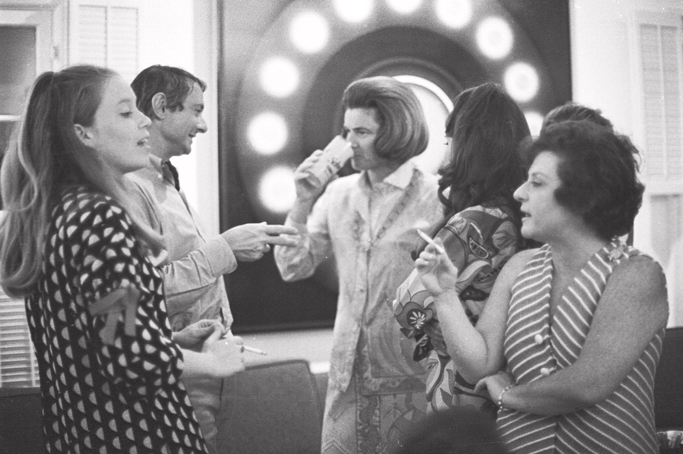
Eugenia Butler Speaking with Elise Grinstein, Dinner Party for Roy Lichtenstein at Betty Asher's Home (1968)
Malcolm Lubliner
Photograph by Malcolm Lubliner
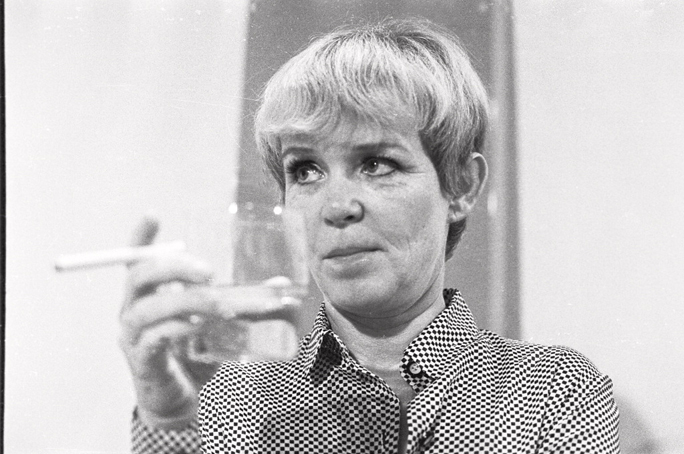
Eugenia Butler, Sr., at Dinner Party for Roy Lichtenstein at Betty Asher's Home (1968)
Malcolm Lubliner
Photograph by Malcolm Lubliner All rights reserved © Malcolm Lubliner
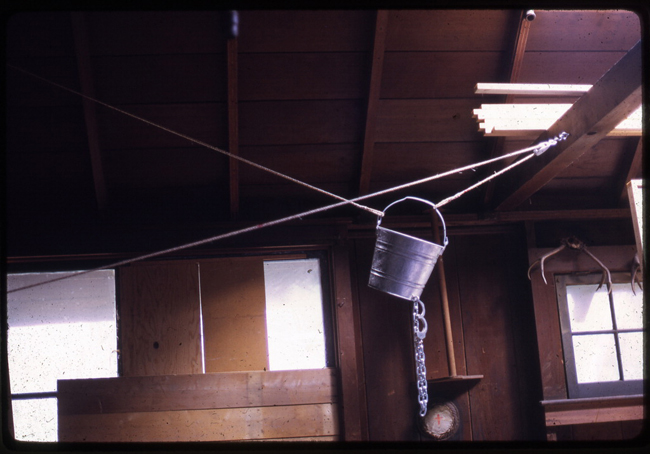
Untitled (1969)
Richard Jackson
Bucket and hardware in artist's studio
Image courtesy of Eugenia P. Butler Estate © Eugenia P. Butler Estate


